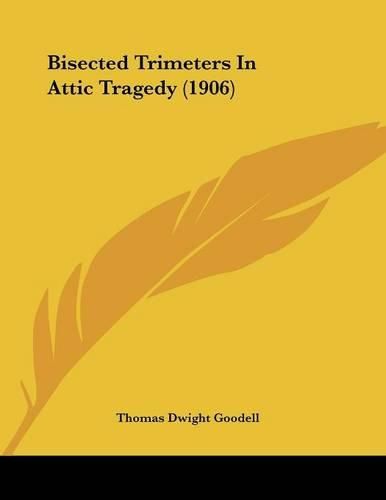Readings Newsletter
Become a Readings Member to make your shopping experience even easier.
Sign in or sign up for free!
You’re not far away from qualifying for FREE standard shipping within Australia
You’ve qualified for FREE standard shipping within Australia
The cart is loading…






Bisected Trimeters In Attic Tragedy is a book written by Thomas Dwight Goodell and originally published in 1906. The book is an in-depth analysis of the use of bisected trimeters in ancient Greek tragedy, specifically in the works of Aeschylus, Sophocles, and Euripides. Goodell examines the structure, rhythm, and meaning of these verses, which are known for their distinctive use of caesura, or a pause in the middle of a line. The book includes detailed examples and explanations of the use of bisected trimeters in various plays, as well as discussions of their historical context and significance. This book is a valuable resource for scholars and students of ancient Greek literature, as well as anyone interested in the technical aspects of poetic form.This scarce antiquarian book is a facsimile reprint of the old original and may contain some imperfections such as library marks and notations. Because we believe this work is culturally important, we have made it available as part of our commitment for protecting, preserving, and promoting the world's literature in affordable, high quality, modern editions, that are true to their original work.
$9.00 standard shipping within Australia
FREE standard shipping within Australia for orders over $100.00
Express & International shipping calculated at checkout
Bisected Trimeters In Attic Tragedy is a book written by Thomas Dwight Goodell and originally published in 1906. The book is an in-depth analysis of the use of bisected trimeters in ancient Greek tragedy, specifically in the works of Aeschylus, Sophocles, and Euripides. Goodell examines the structure, rhythm, and meaning of these verses, which are known for their distinctive use of caesura, or a pause in the middle of a line. The book includes detailed examples and explanations of the use of bisected trimeters in various plays, as well as discussions of their historical context and significance. This book is a valuable resource for scholars and students of ancient Greek literature, as well as anyone interested in the technical aspects of poetic form.This scarce antiquarian book is a facsimile reprint of the old original and may contain some imperfections such as library marks and notations. Because we believe this work is culturally important, we have made it available as part of our commitment for protecting, preserving, and promoting the world's literature in affordable, high quality, modern editions, that are true to their original work.